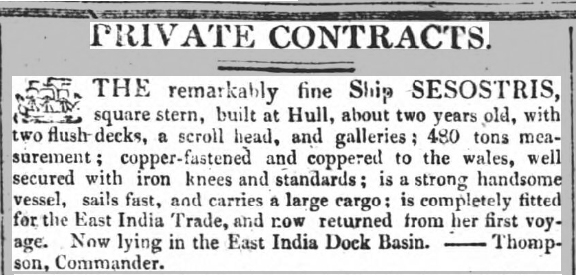| Date |
Event (info. mainly from Lloyds Underwriters' books) |
| 1819 |
Voyage to Bengal under Captain Thompson. Owner Staniforth. Surveyed in April at Hull, and registered.
Ist Class ship of 1st Class materials, with iron cables. Iron standards and knees. Sheathed with copper. |
| 1822 |
Voyage to Archangel under Captain Porter. Surveyed at Hull as 1st Class ship of 1st Class materials.
Owner Reed & Co. |
| 1823 |
Voyage to Lima under Captain A. Robson. Owner Staniforth. Patent Felt used. Proved iron cables.
Surveyed at London, 1st Class ship of 1st Class materials. Sheathed with copper over boards.
The London Courier and Evening Gazette, of 21st September, 1824, reporting on the efforts of Simon Bolivar to overthrow the Spanish,
publishes a letter from Capt. Robson of Sesostris
to his Owners, dated Callao Bay, May 4, 1824:-
"At present we have no certain information of the position of the armies,
or of their force. There was a report a few days ago of a battle on the plains of Huacca, between Generals Sucre and
Olaneta, in which the latter (the Royalist) had lost upwards of 2,000 men, and retired on Guamanga. It has not since been
contradicted, and is probably correct. General Bolivar is to the northward, in the province of Truxillo, but the
communication being cut off, we are ignorant of his proceedings. It is said that he is very sanguine as to the
result of the campaign."
|
| 1825 |
Copper repaired.
Morning Post, 30 November 1825:
PORTSMOUTH, Nov. 28.- It has blown very hard all the day; the outward bound remain
all well. The Hope, Edwards, from Exmouth to London, got on shore on Bambridge Ledge this morning, knocked her rudder off,
and is leaky; in making for the harbour, accompanied by two pilot boats, she ran on board the Sesostris, for New South Wales, and carried
away her bowsprit.
|
| 1826 |
Voyage taking convicts to New South Wales under Captain Drake. Owner Staniforth.
|
| 1827 |
Voyage to India under Captain Boucher. Owner Watson. Surveyed at London as 2nd Class ship of 2nd Class materials
(1st category). Sheathed with copper over boards. |
| 1828 |
Some repairs |
| 1829 |
Voyage to Bombay under Captain Yates. Owner Watson. Surveyed in August as 2nd Class ship and in September
as of 2nd Class materials at Liverpool. Part new upper works and some repairs. |
| 1830 |
Owner Yates & Co. |
| 1831 |
Voyage to India under Captain Liddle. Owner Yates & Co.
[This was presumably in late 1831 after Sesostris had returned to London on Smith's voyage - SK note] |
| 1833 |
Voyage to India under Captain Yates. Owner Yates & Co. |
|
|
| 1840 |
Voyage to Sydney under Captain Row. Registered as a Barque. Owners Tomlin & Co. |
| 1841 |
Used on the Australian coastal trade |
| 1843 |
Broken up |
| Entry |
Meaning |
| 420 |
The number of the entry under the letter 'S'. |
| S |
Ship |
| s |
Sheathed |
| PF |
Patent felt |
| W23 & C27 |
Sheathed with copper over boards in 1823 and 1827 |
| YATES |
Captain Yates |
| rp 28&29 |
Repaired in 1828 and 1829 |
| 487 |
487 tonnes. As there is no entry under the tonnage, the vessel had two decks |
| HULL |
Hull was the port of register |
| I.S.& K |
Iron standards and knees |
| 12 |
12 years' old |
| WATSON |
The owner was Watson |
| 19 |
19 feet of draught when loaded |
| pt n.u.w. & Srprs 29 |
Part new upper works and some repairs in 1829 |
| Li |
Liverpool was the port of survey |
| Bomby |
Bombay was the destination of the insured voyage |
| I PIC IH |
Proved iron cables |
| E |
Second class ship, ie able to carry any cargo, though not guaranteed to be watertighta |
| 8 |
Month of survey, ie August |
| 9 |
Month of survey, ie September. |
Sesostris I, (1971 - 1928 BC), was the second king of the 12th dynasty of ancient Egypt. He was the son of Amenemhet I.
To secure the throne for himself after Amenemhet's assassination, he publicized his father's testament The Instructions of
Amenemhet, which became an Egyptian literary classic. Sesostris conquered Nubia during his prosperous reign, and was
succeeded by his son Amenemhet II.
Sesostris II was the son of Amenemhet II and the grandson of Sesostris I. He was succeeded, in turn, by his son Sesostris III (1878 -1843 BC). Sesostris III fixed Egypt's southern border above the second cataract of the Nile. He waged campaigns against the Libyans of the Western Desert and to secure Egyptian influence and trade ties with Syria and Palestine. He curbed the power of the nobility and supervised the design and construction of numerous public works. He was buried in a small pyramid at Dahshur, about 26 km south of Cairo.
Source : Grolier Encyclopedia, 1993

